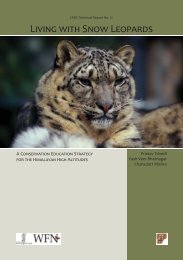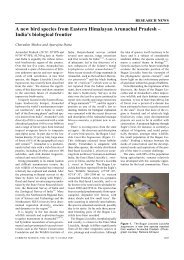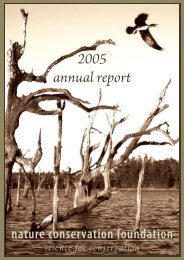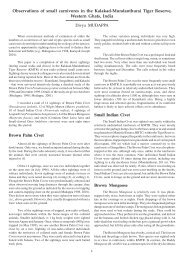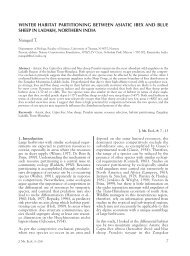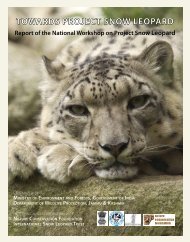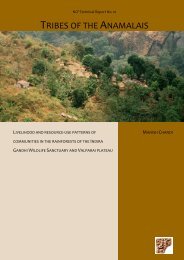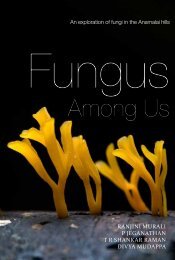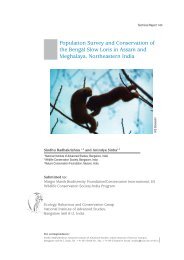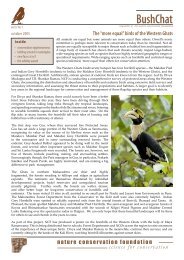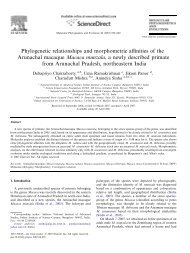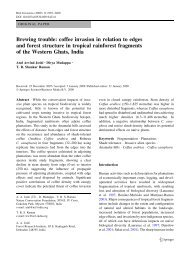2006-7 annual report - Nature Conservation Foundation
2006-7 annual report - Nature Conservation Foundation
2006-7 annual report - Nature Conservation Foundation
Create successful ePaper yourself
Turn your PDF publications into a flip-book with our unique Google optimized e-Paper software.
Survival of mammal populations in rainforest fragments<br />
Assessing the conservation value of rainforest fragments<br />
on lands outside protected areas, such as private<br />
lands, is gaining increasing attention in global conservation<br />
priorities. NCF, in a study by Hari Sridhar, examined<br />
mammal populations in tropical rainforest fragments<br />
and assessed their status through comparisons<br />
with earlier studies.<br />
The study estimated mammal densities using linetransect<br />
sampling, in five protected rainforest patches<br />
within the Indira Gandhi Wildlife Sanctuary and four<br />
private rainforest fragments on the Valparai plateau. As<br />
many as 24 out of 28 mammal species recorded in protected<br />
rainforests, also persisted in fragments on private<br />
land. Comparisons between fragments and sanctuary<br />
sites showed that 8 out of 10 species evaluated<br />
maintained similar densities in these two strata (see<br />
figure).<br />
The lion-tailed macaque (Macaca silenus), an<br />
endangered Western Ghats endemic, achieved much<br />
higher density and average troop sizes in the private<br />
fragments compared to the sanctuary. Densities in fragments<br />
(total number of individuals divided by fragment<br />
area) could have however been artificially inflated because<br />
all species also use larger areas around the fragments<br />
to forage or move through—a sort of artificial<br />
‘compression’ effect. Nevertheless, the persistence of<br />
most mammals in fragments can be attributed to low<br />
hunting pressure, the ability to use surrounding plantations,<br />
lowered predation pressures, and increased food<br />
availability in and around fragments for terrestrial and<br />
arboreal mammals. For example, fruit trees such as jackfruit<br />
and shade trees in coffee plantations around frag-<br />
ments provide leaves and fruits for arboreal mammals<br />
such as Indian giant squirrels and lion-tailed macaques.<br />
The relatively degraded private fragments also contain<br />
grass and secondary vegetation used by ungulates such<br />
as gaur and barking deer.<br />
We then examined what habitat parameters<br />
were best correlates or predictors of the arboreal mammal<br />
densities. Across sites, these turned out to be different<br />
for different species. Indian giant squirrel (Ratufa<br />
indica) abundance was negatively correlated to canopy<br />
overlap, lion-tailed macaque abundance was negatively<br />
correlated to patch area and canopy overlap, while Nilgiri<br />
langur (Trachypithecus johnii) abundance showed<br />
no significant correlates and was similar across most<br />
sites.<br />
Comparison with estimates from earlier studies<br />
showed that the densities of all three arboreal mammal<br />
species have increased in the last decade, especially in<br />
the private fragments. The persistence and increase in<br />
abundance of mammals in private fragments can be attributed<br />
to a number of reasons—proximity to large<br />
contiguous forests that have remained largely protected<br />
for over a century, low hunting pressure, species’<br />
ability to use matrix habitats, lack of predators, and<br />
high food availability. The relative importance of each<br />
of these needs investigation. While the persistence of<br />
mammals in private fragments is encouraging, effects<br />
of high densities due to the effects of fragmentation or<br />
‘compression’ on long-term population dynamics, behavioural<br />
changes, and social organization also needs<br />
to be looked into.<br />
28<br />
Mammal densities in Indira Gandhi Wildlife Sanctuary (IGWLS) and in fragments on private lands. (Bars = 95% C. I.).<br />
<strong>annual</strong><br />
<strong>report</strong>



